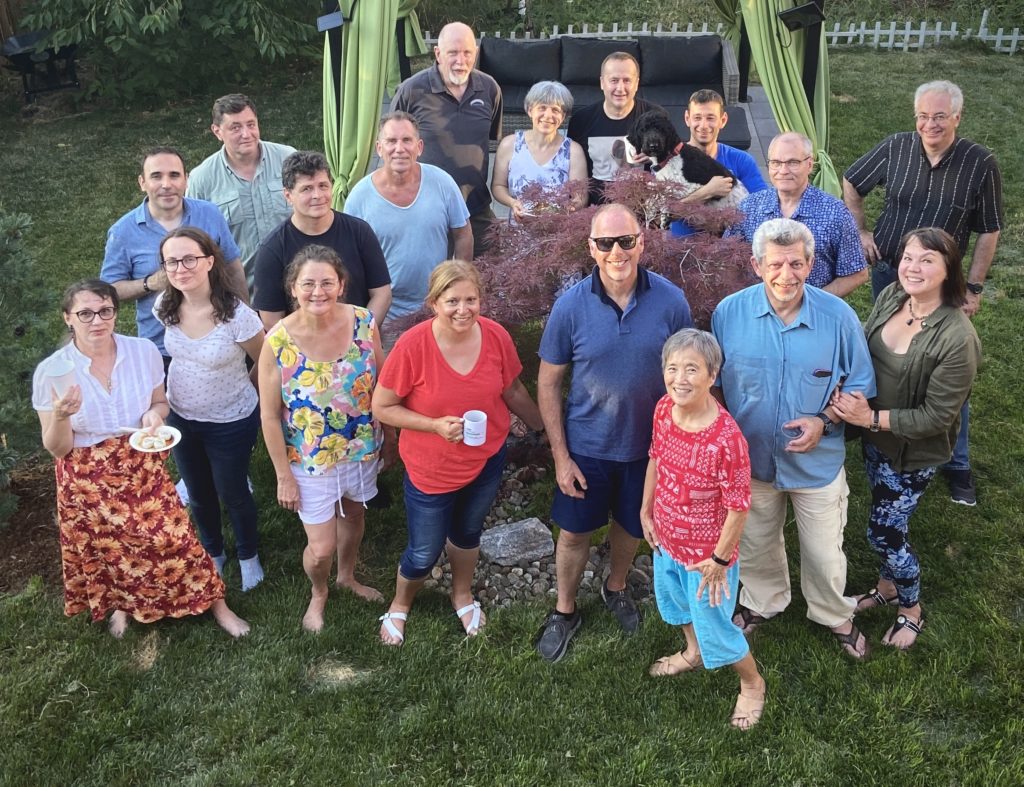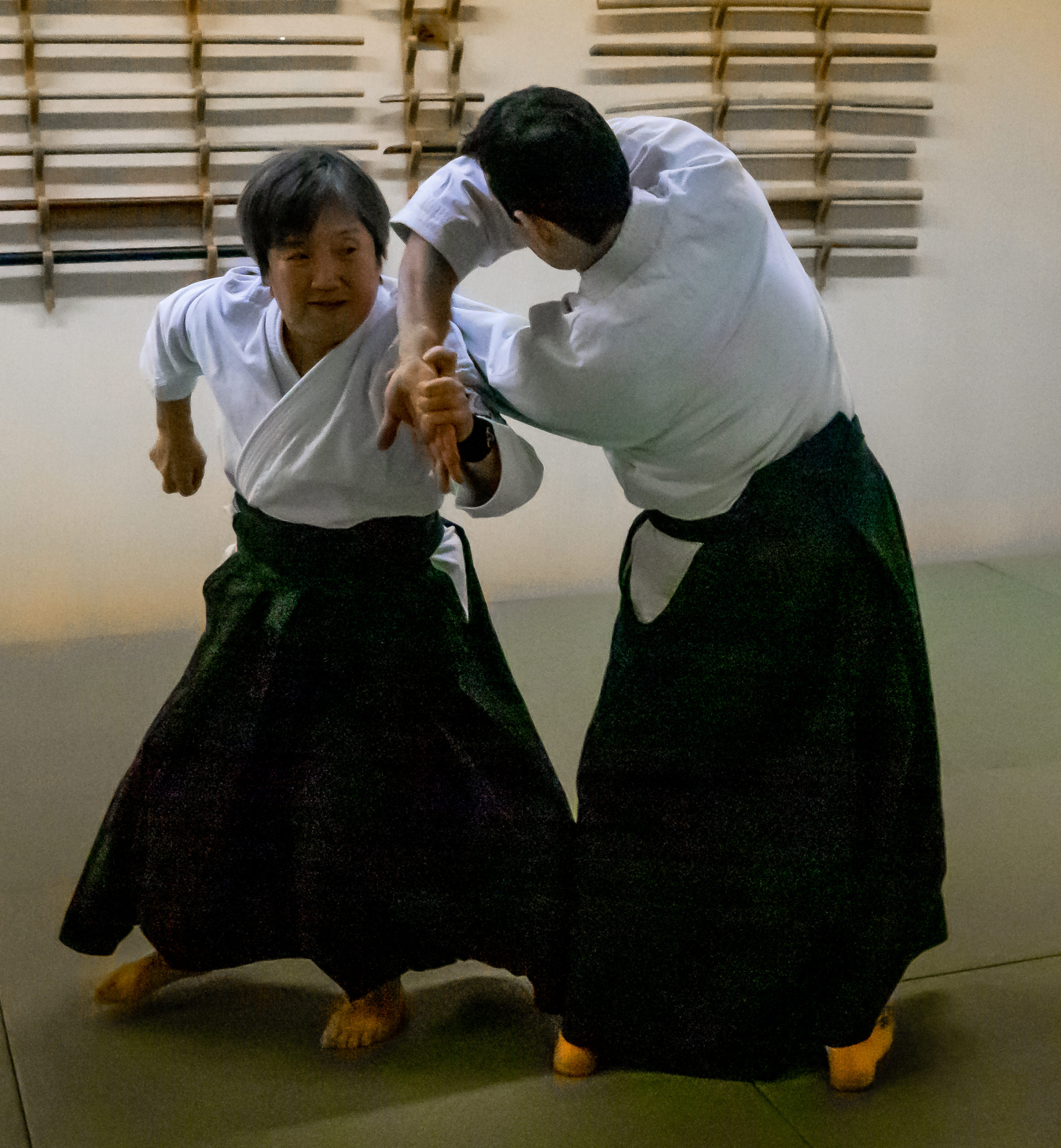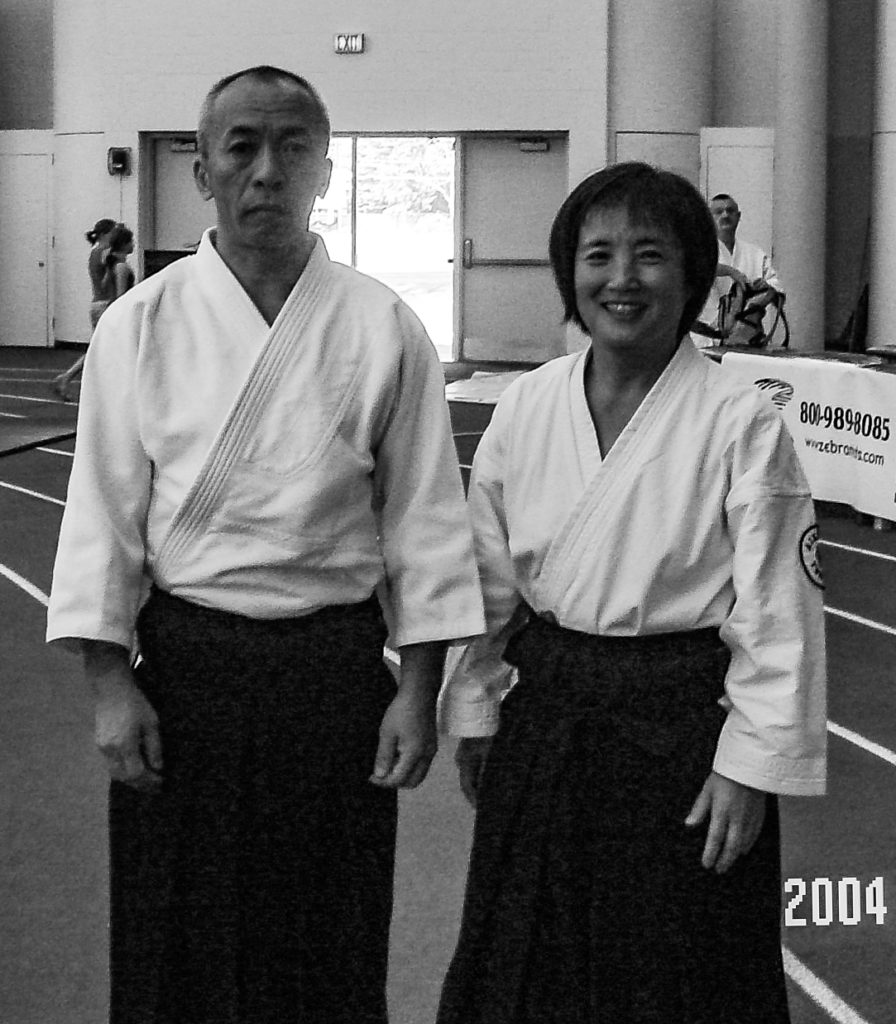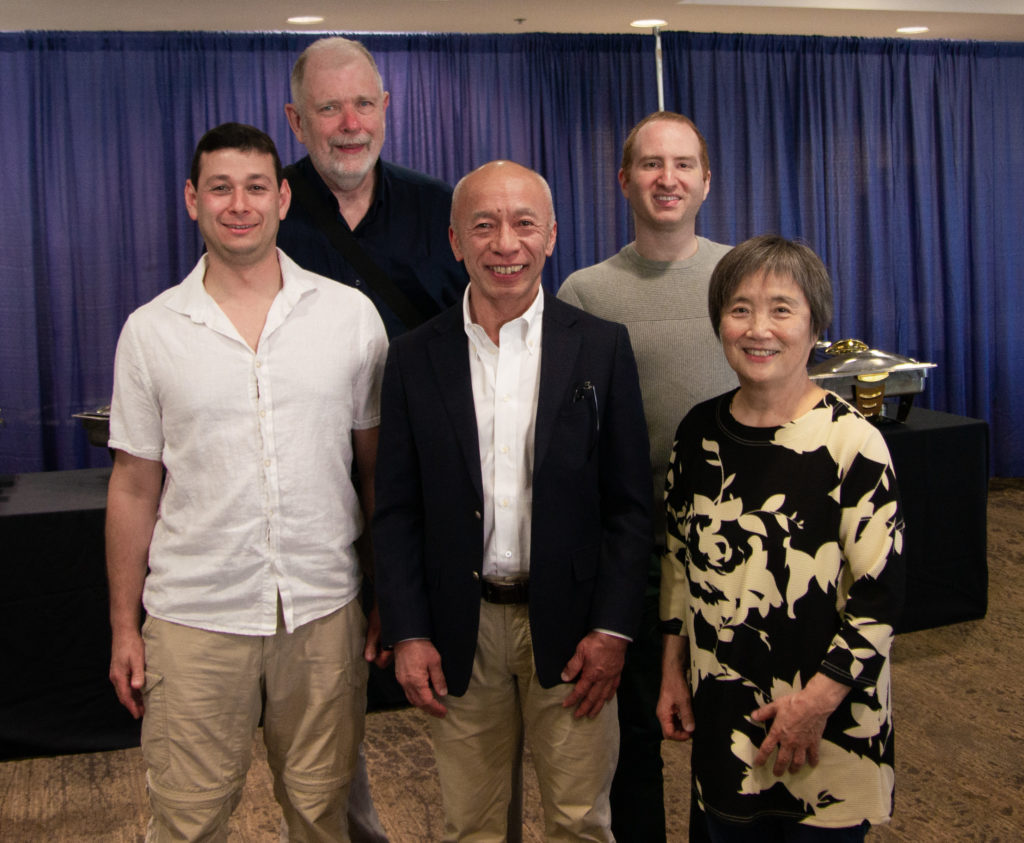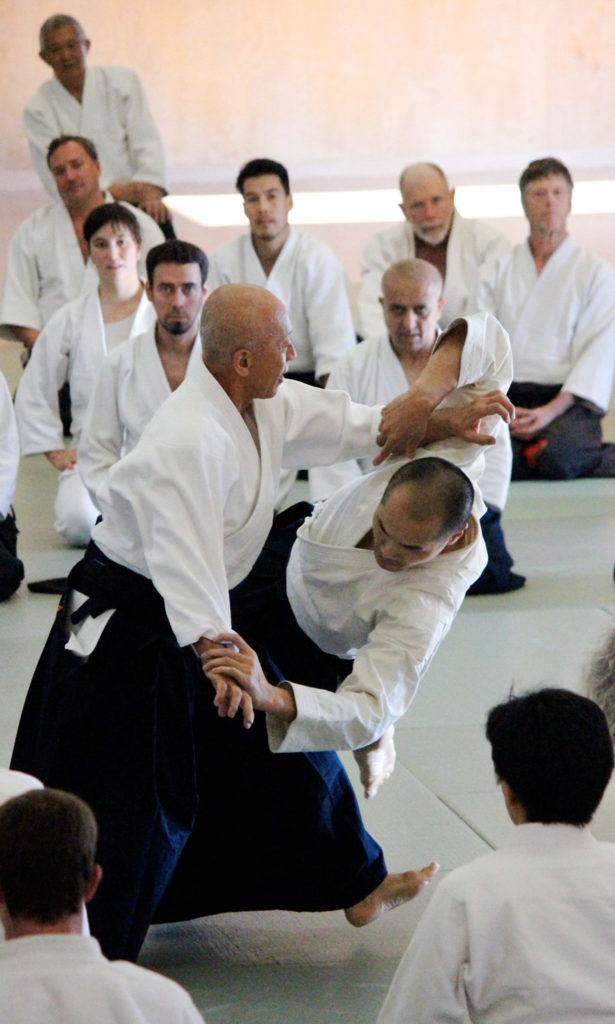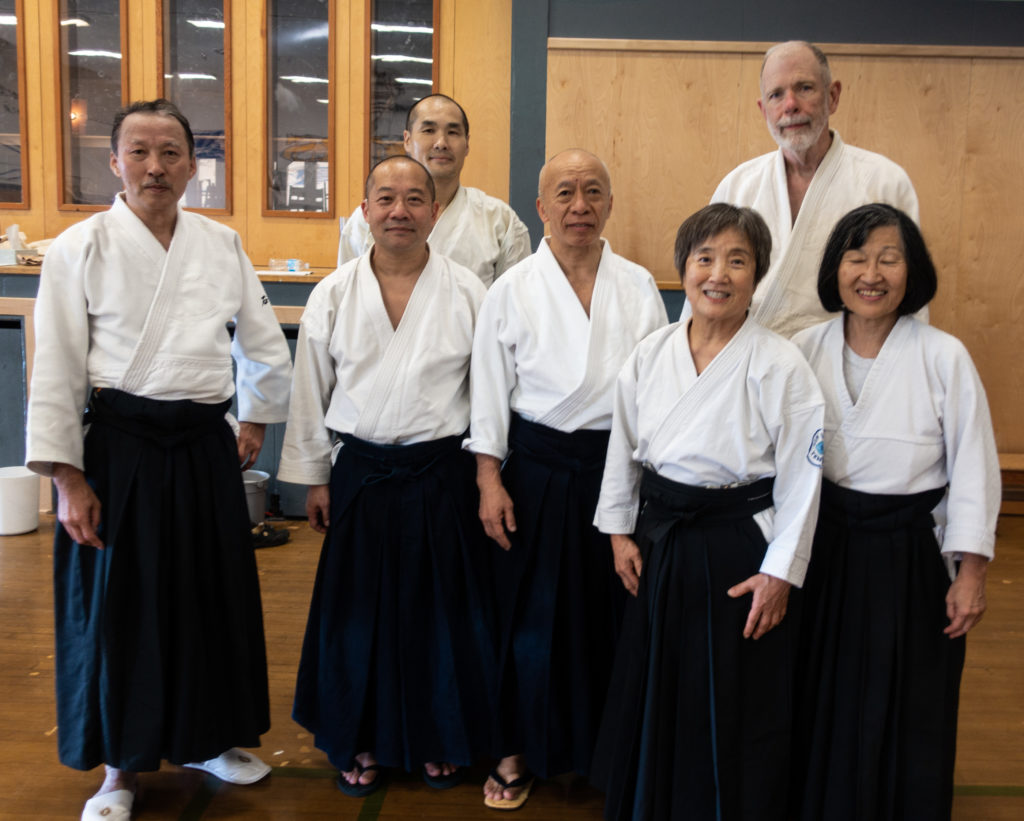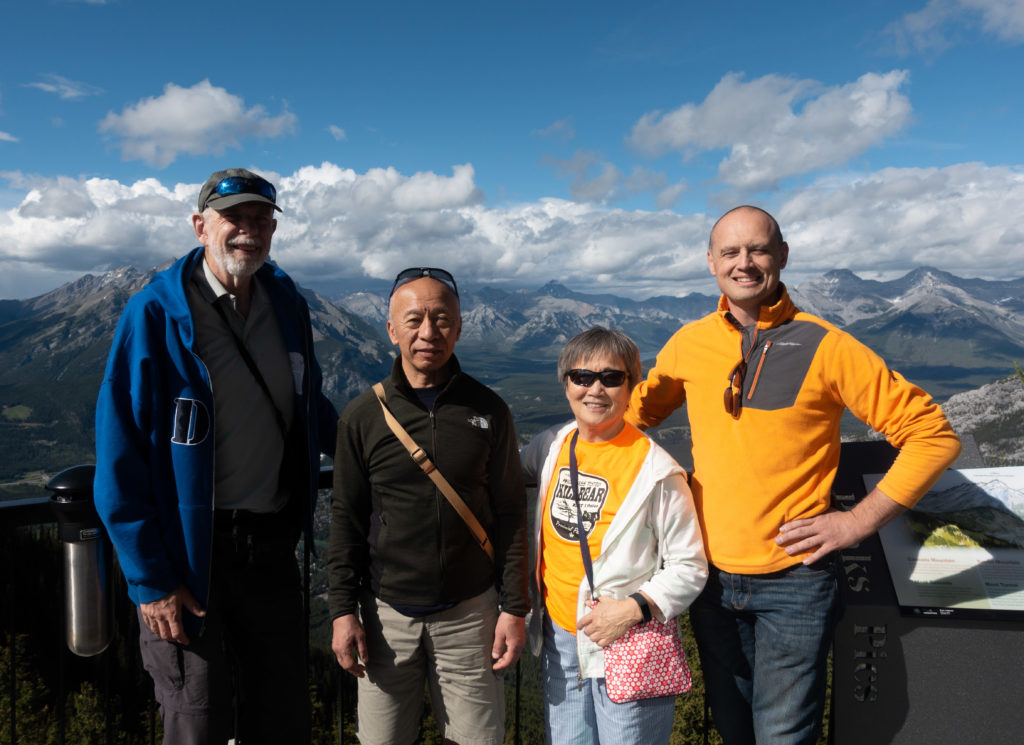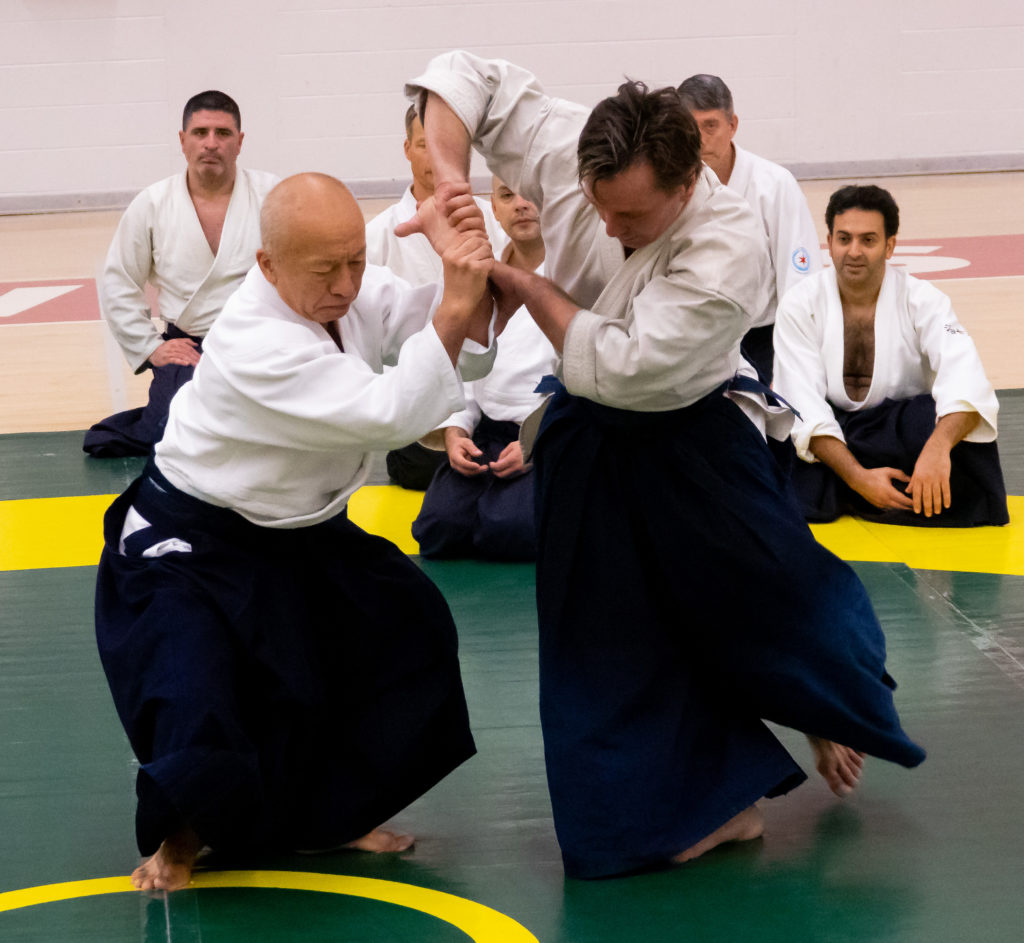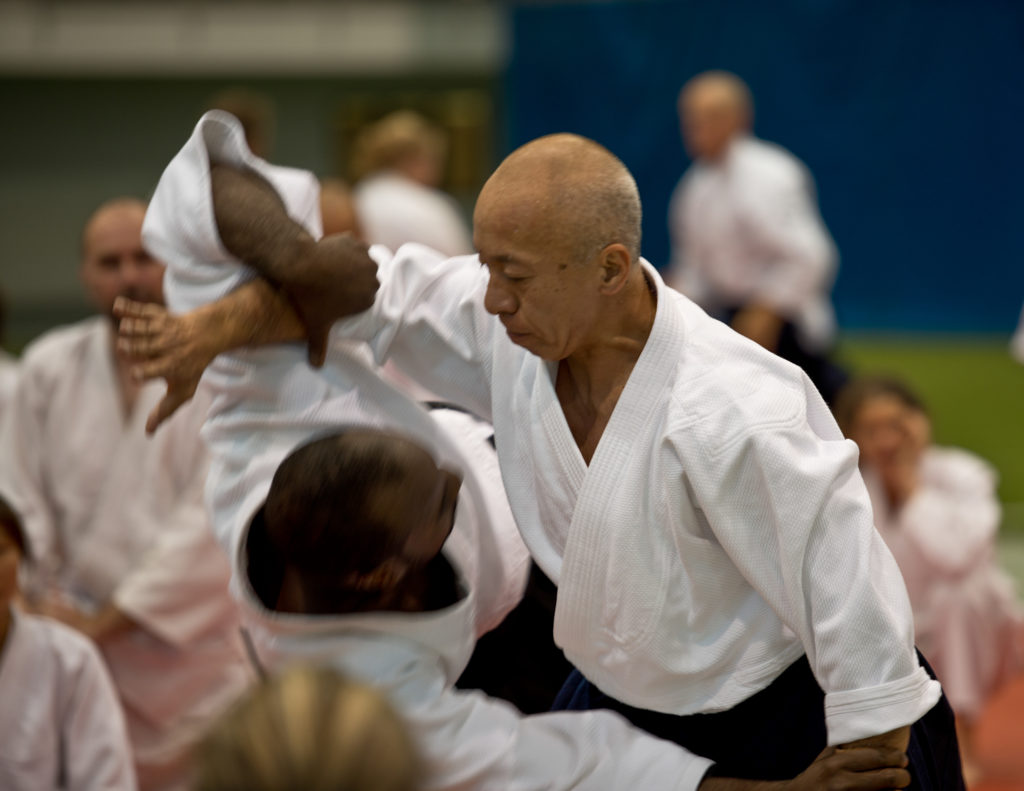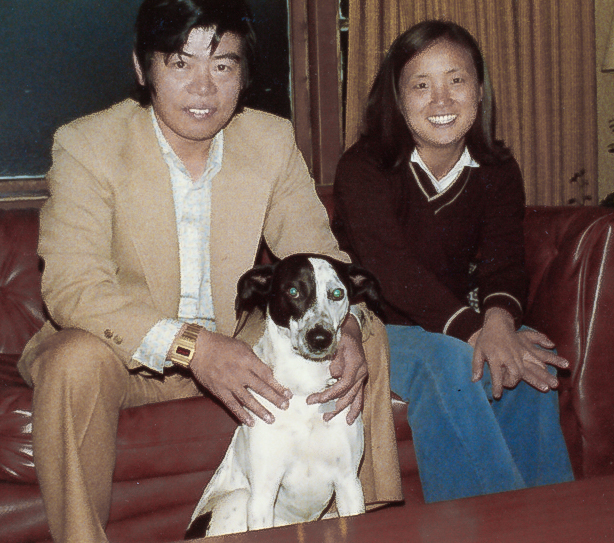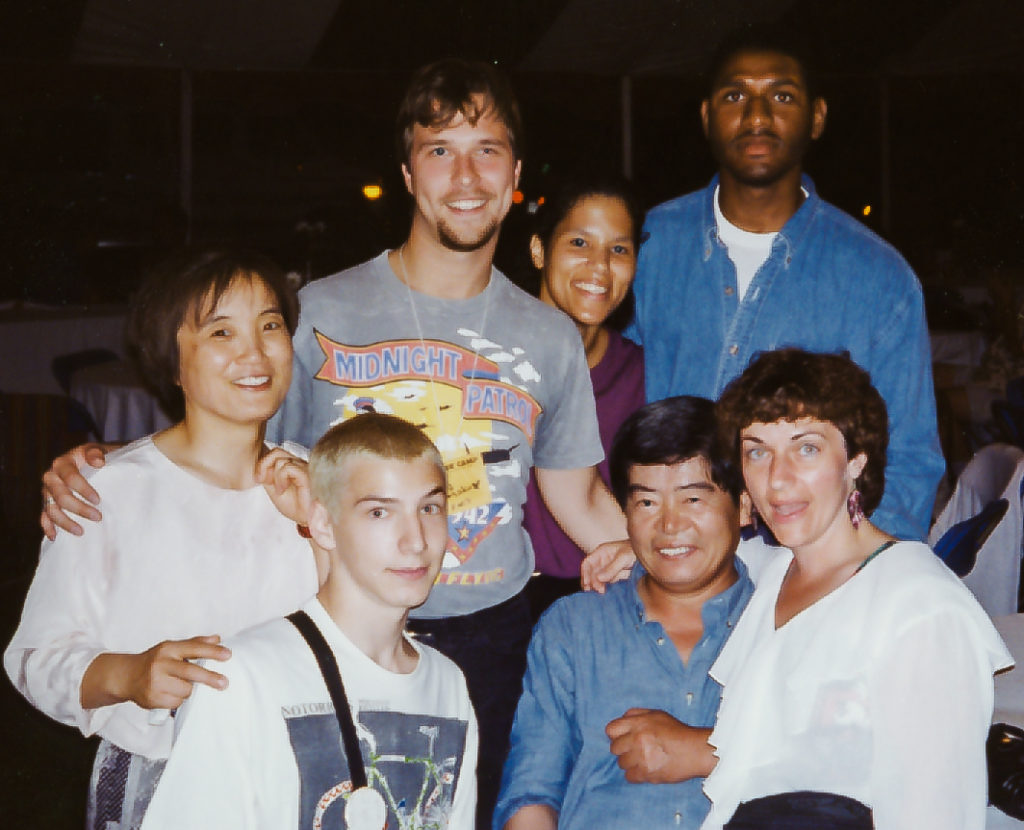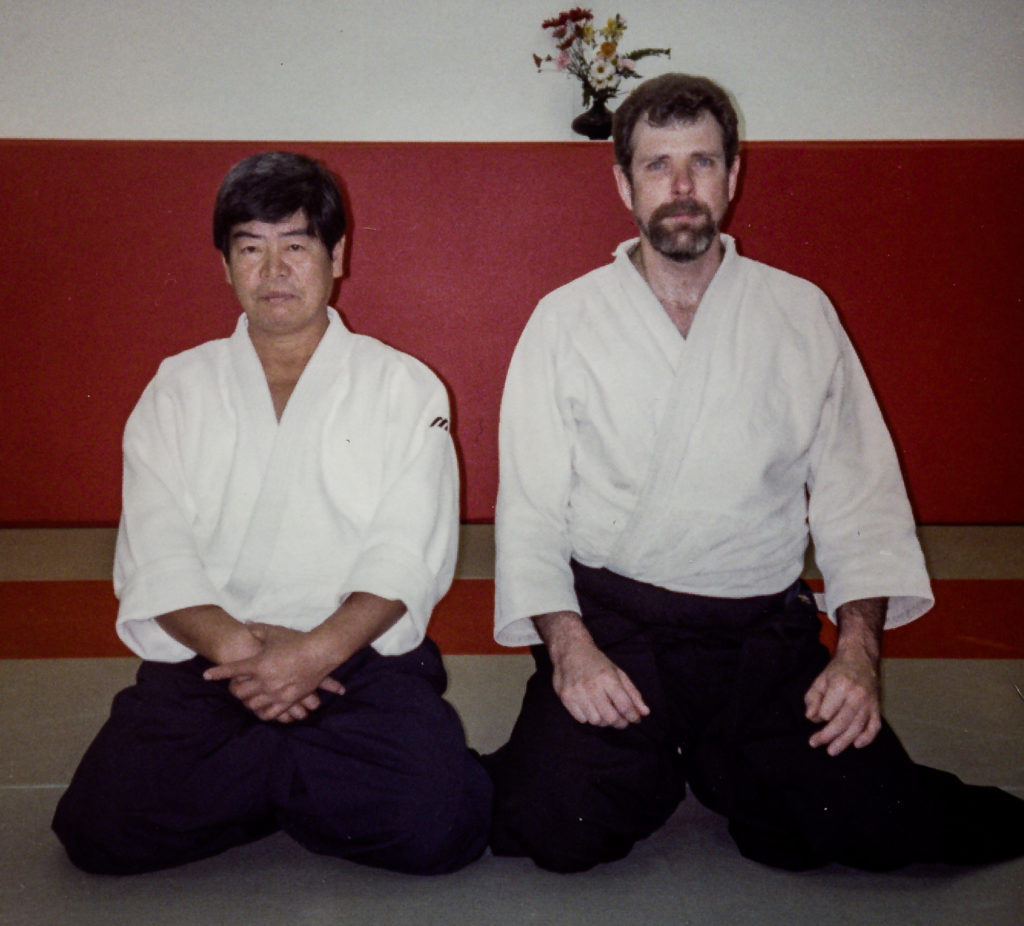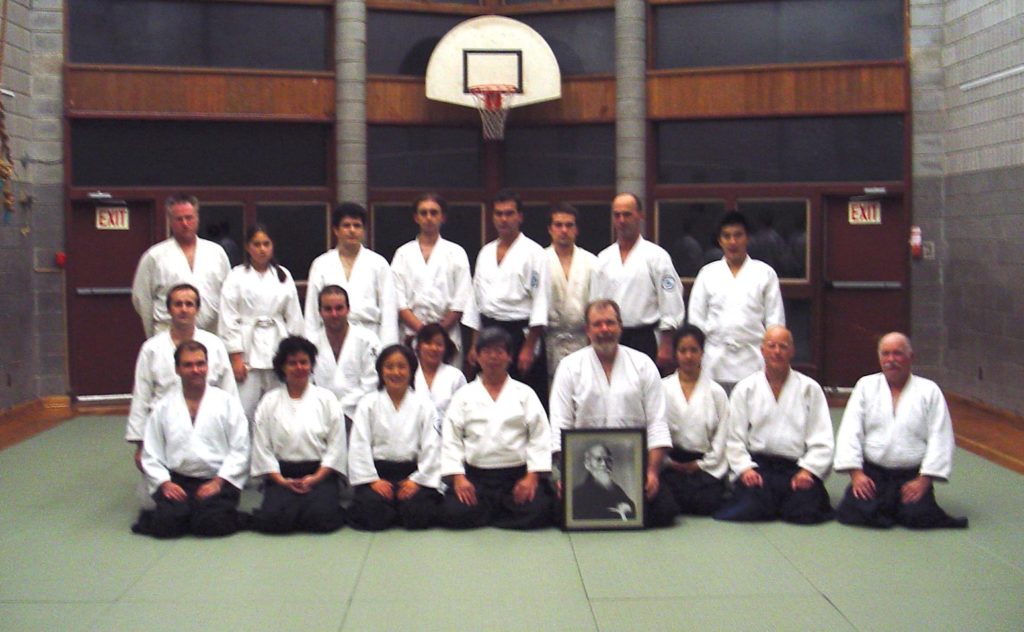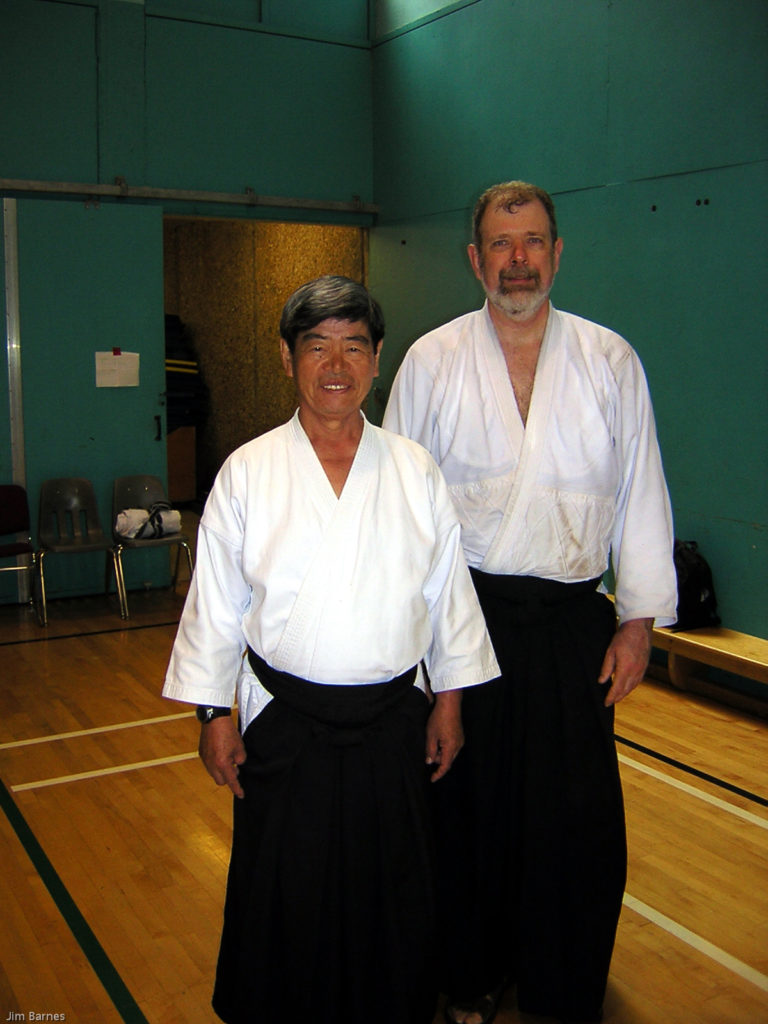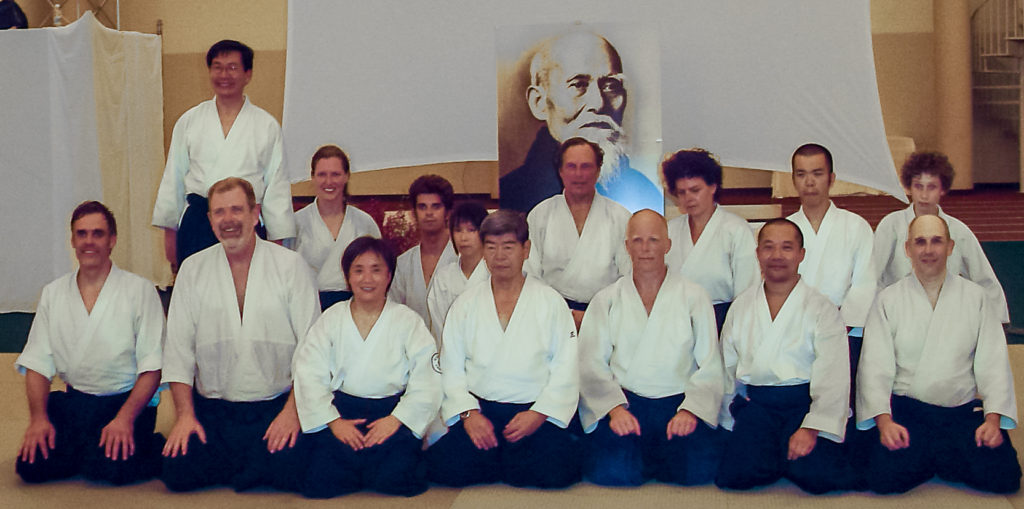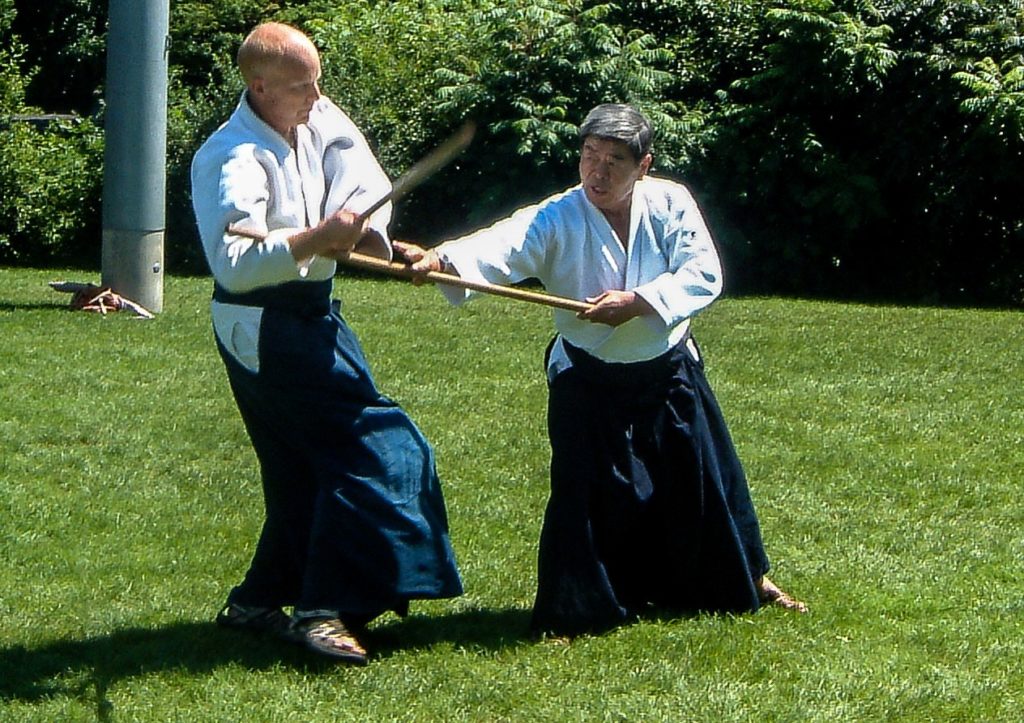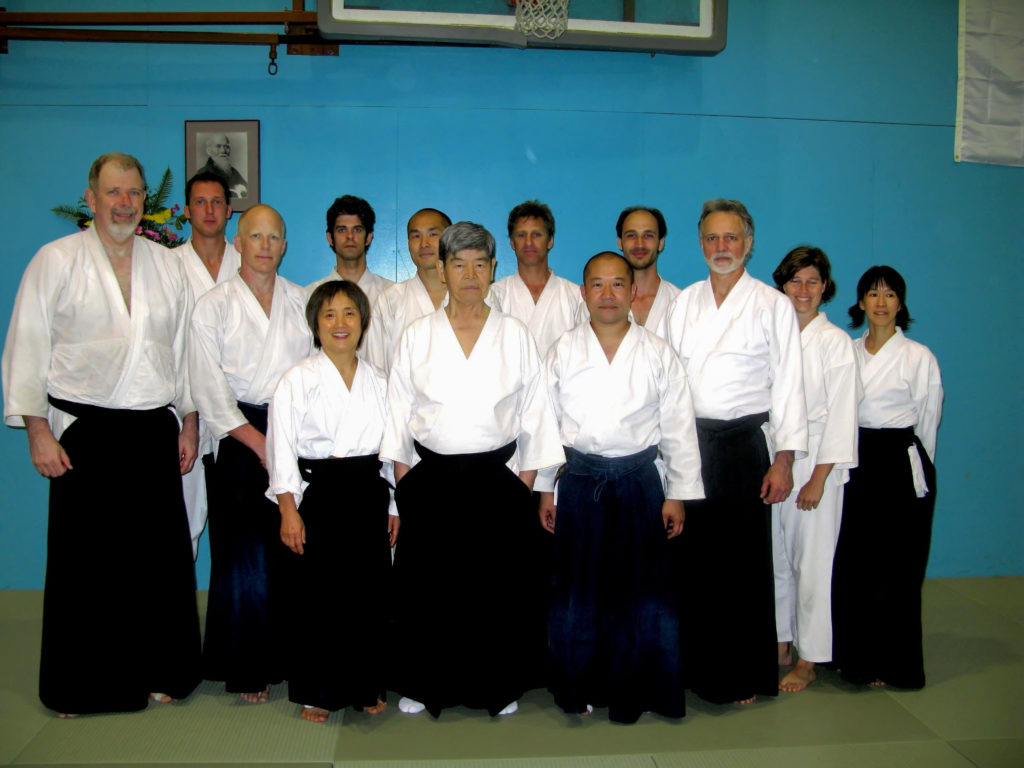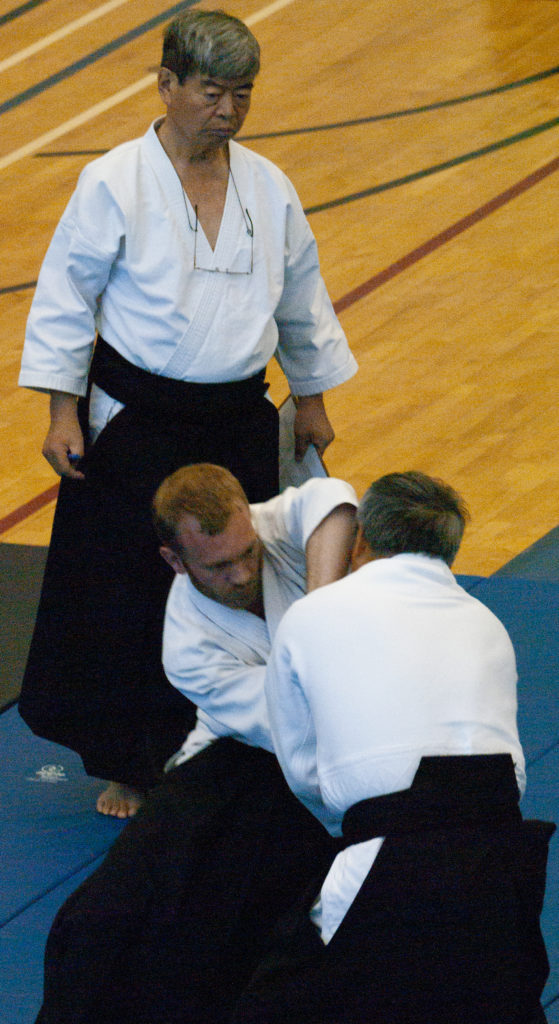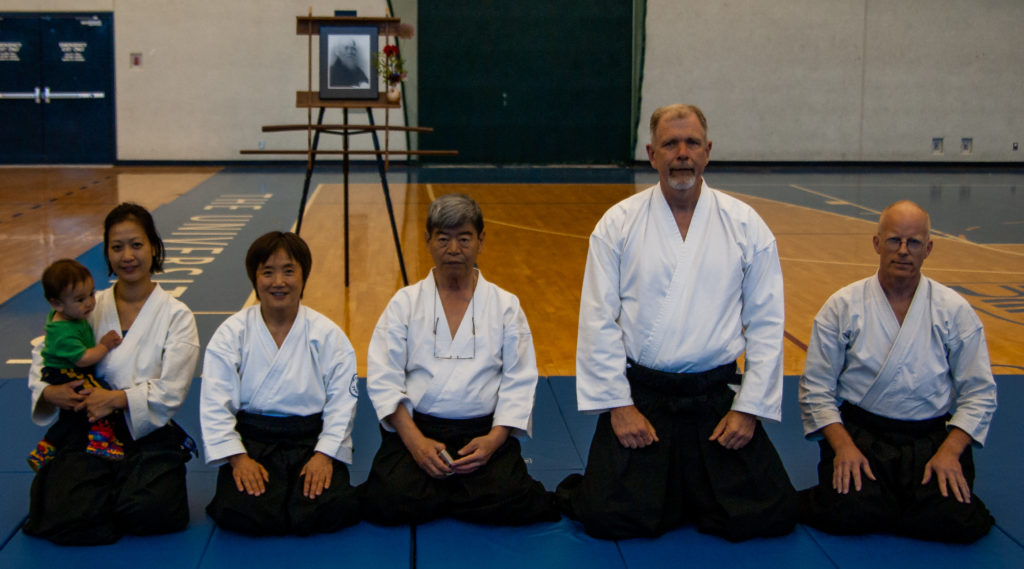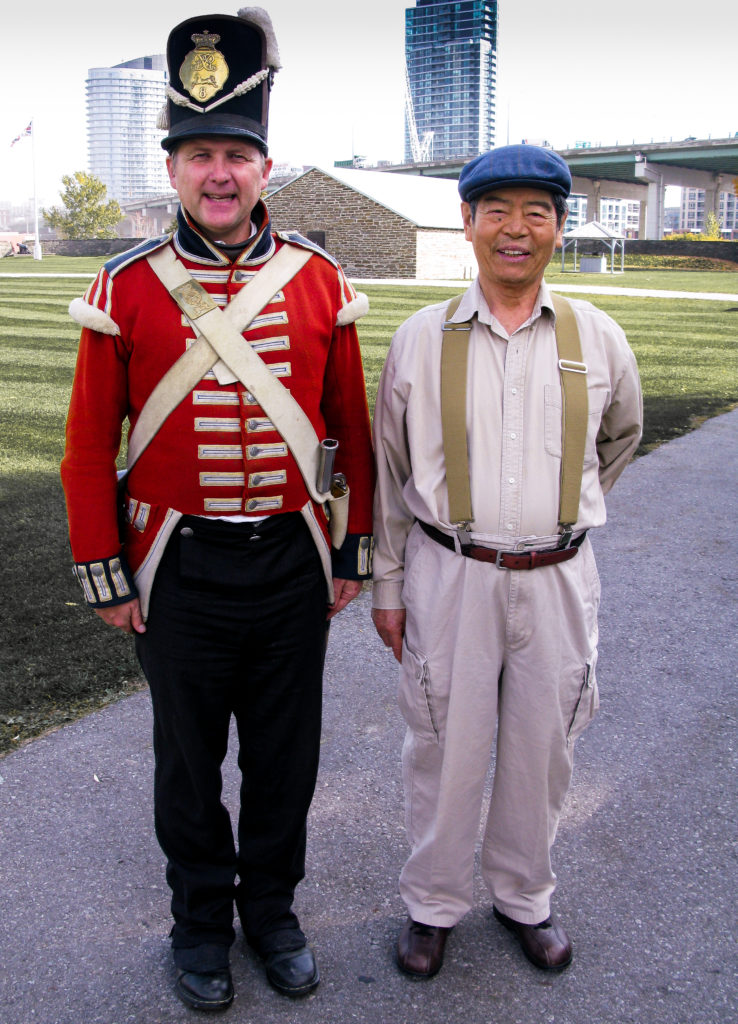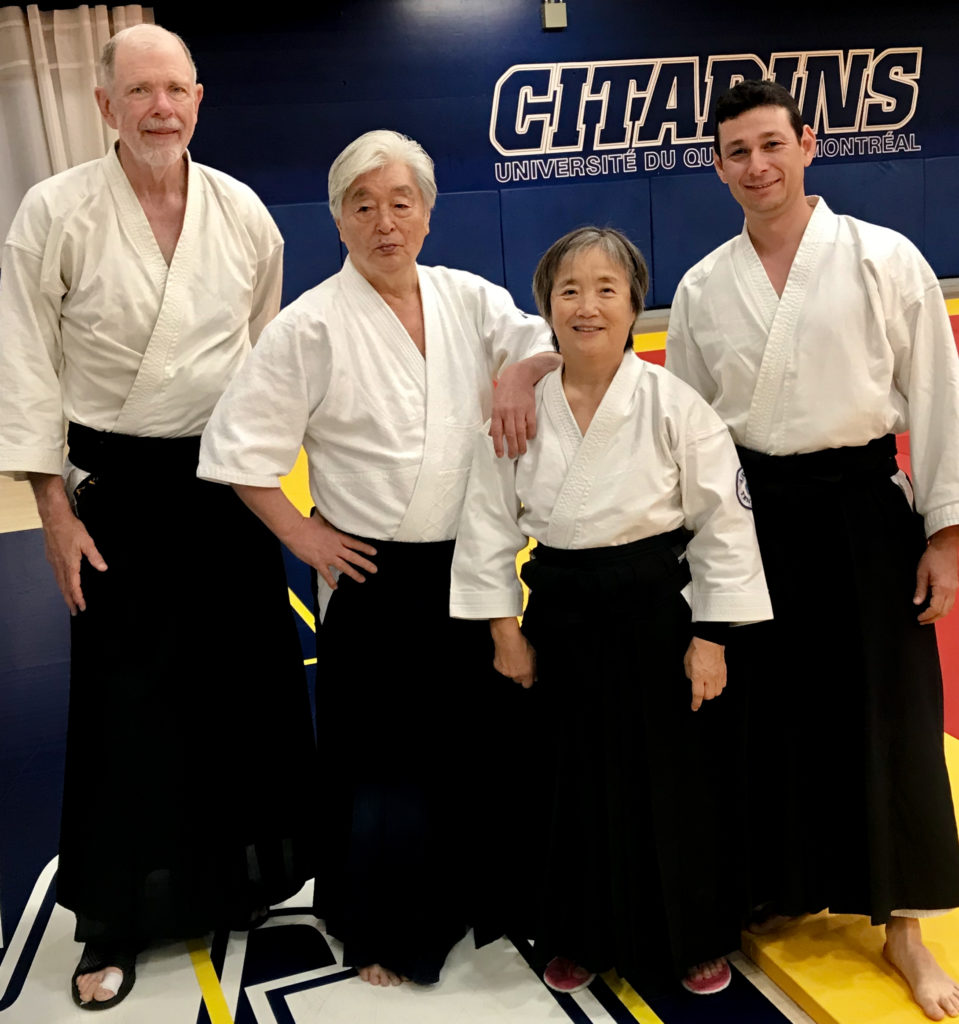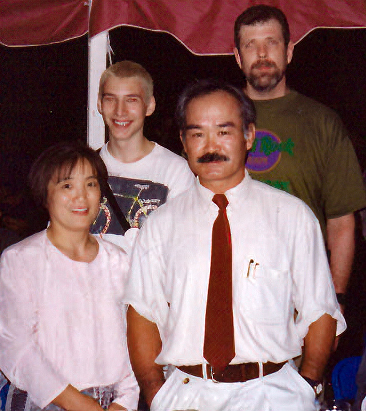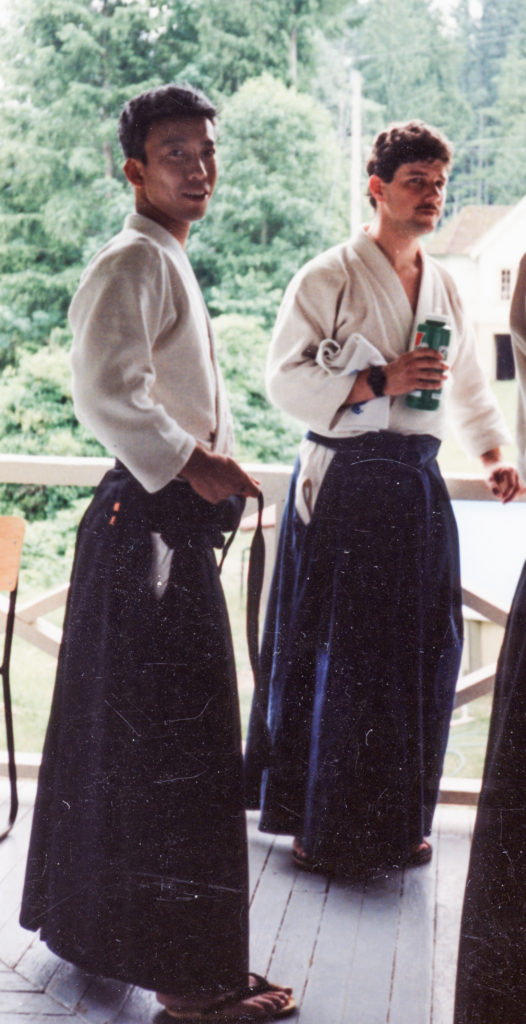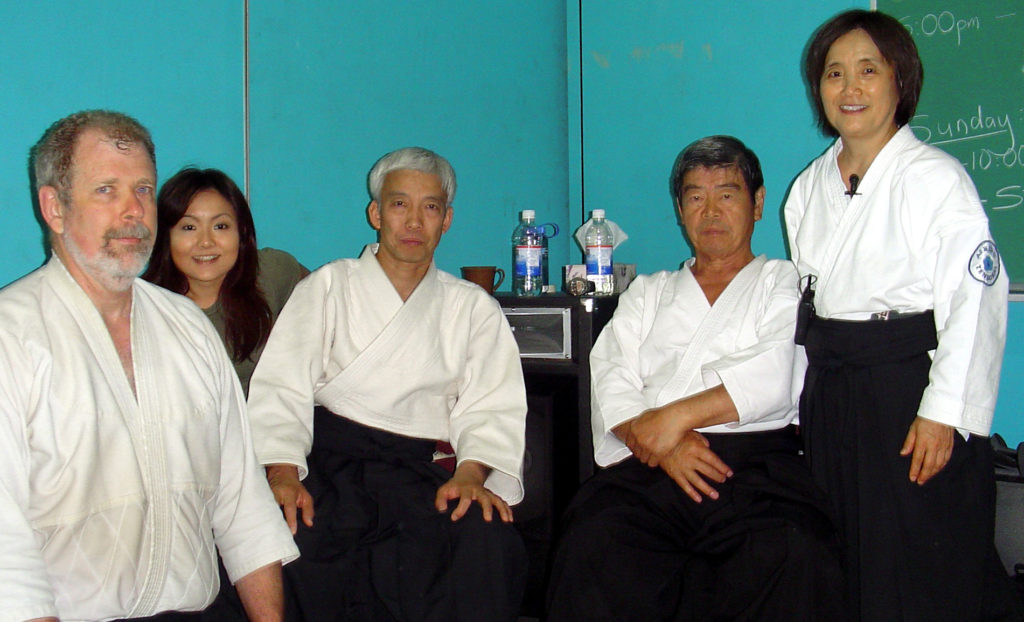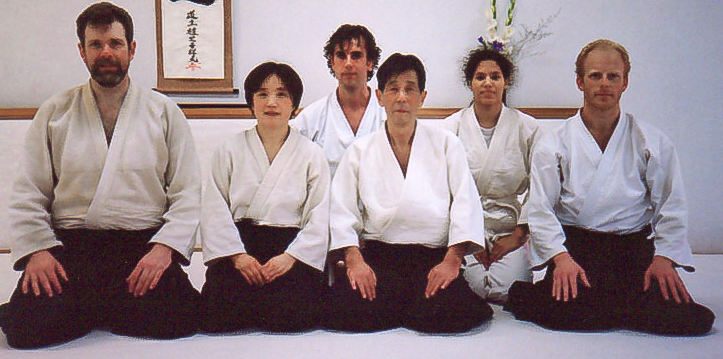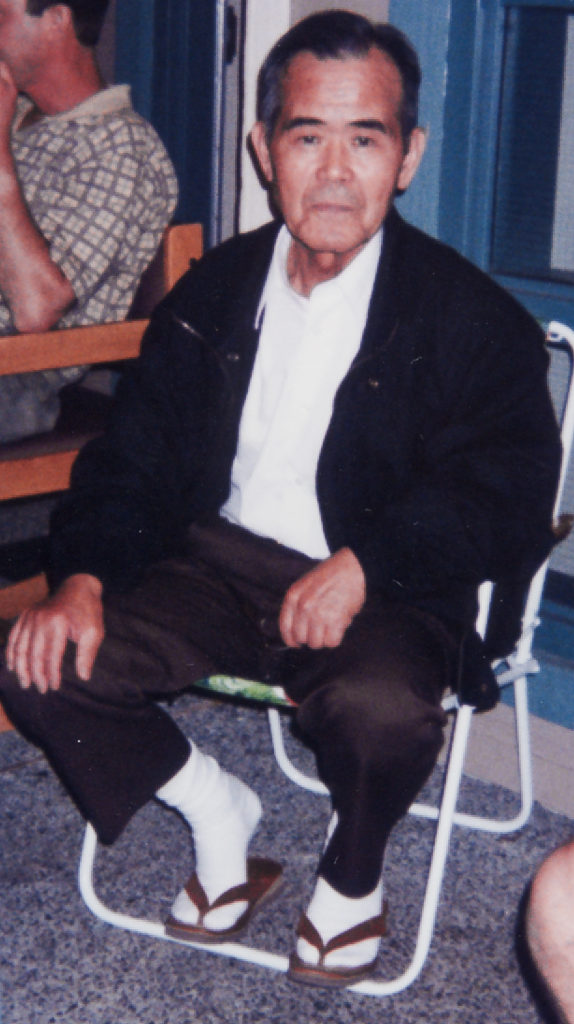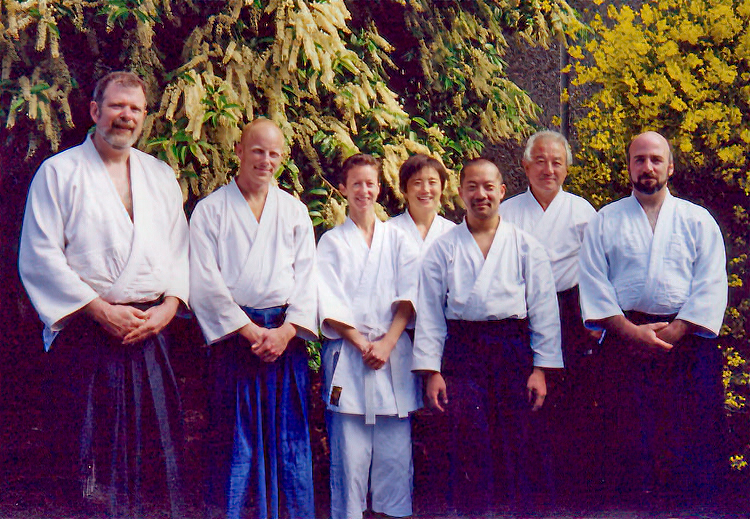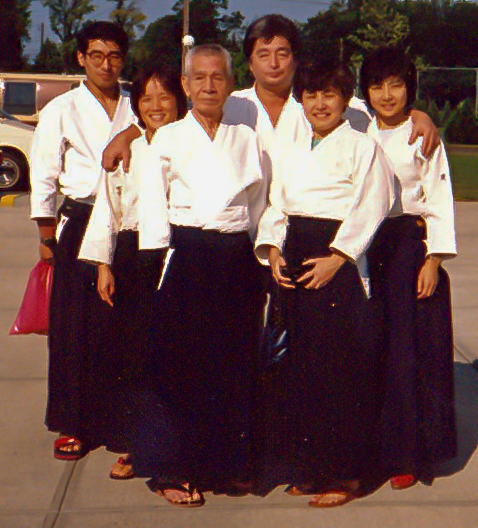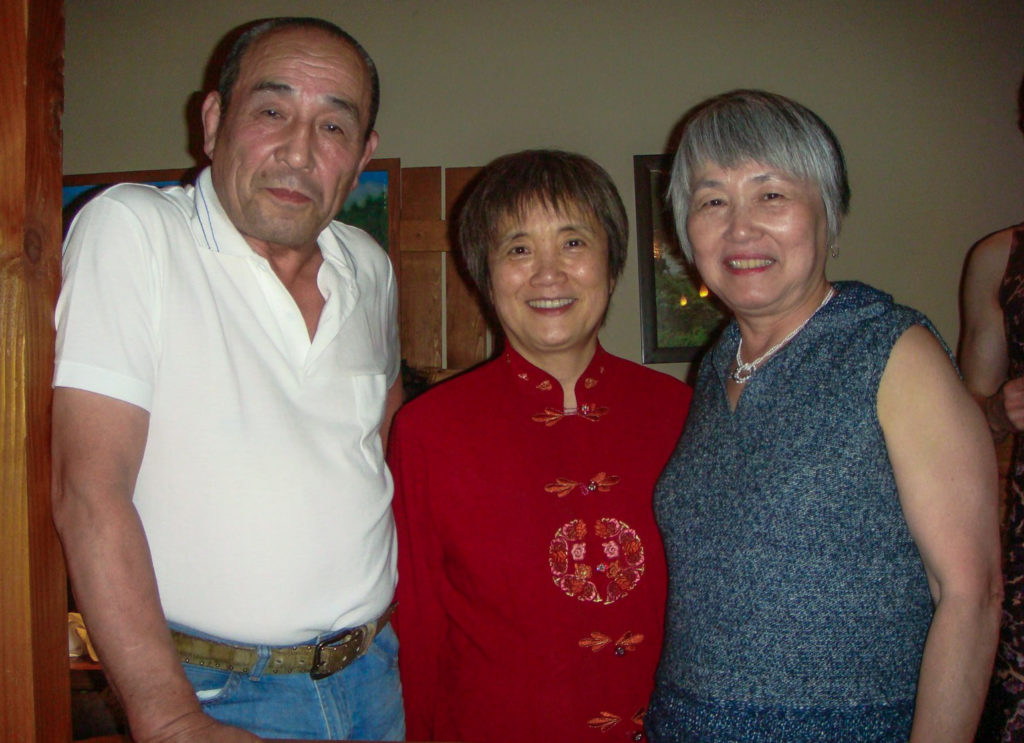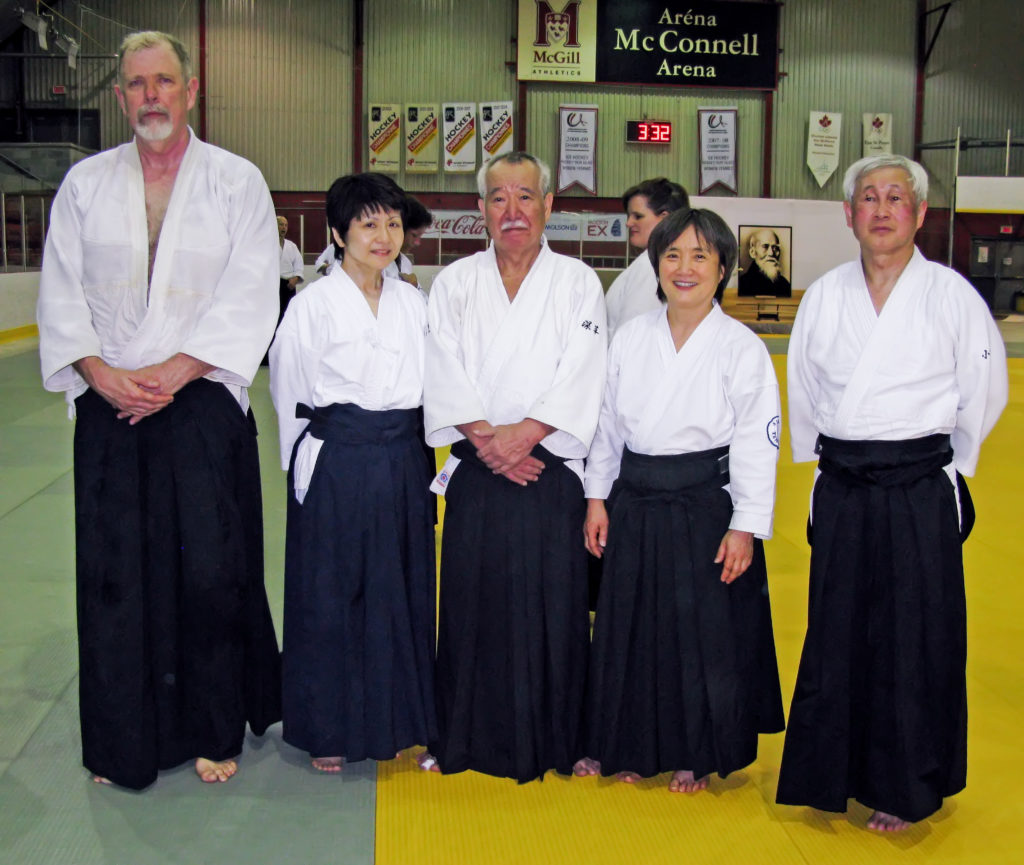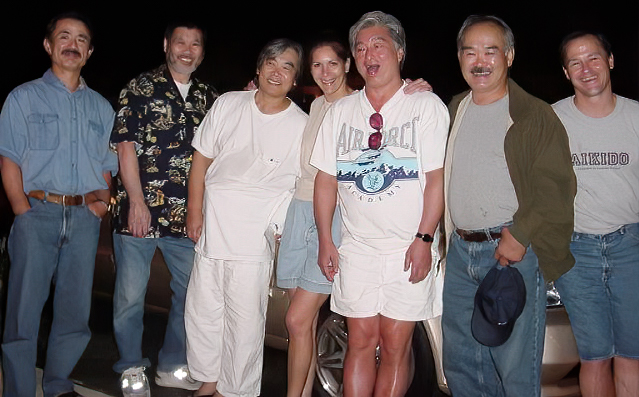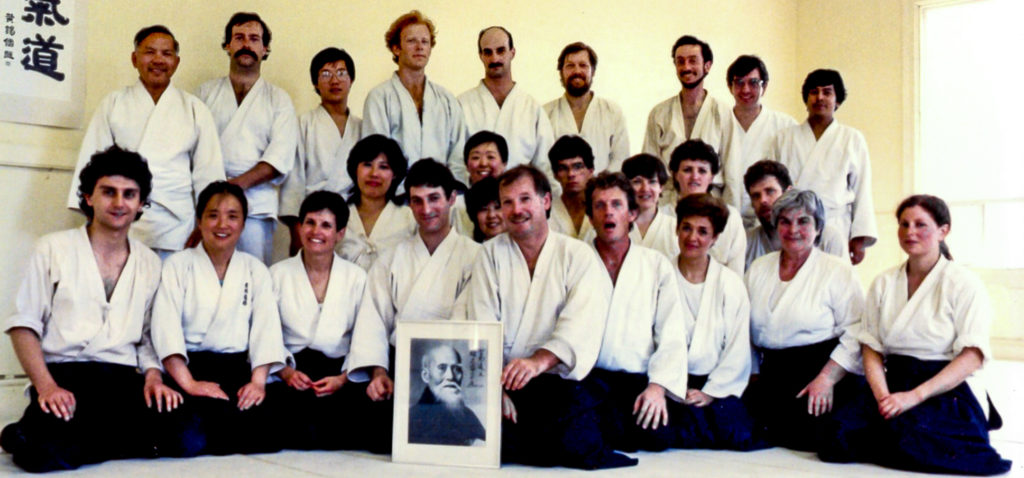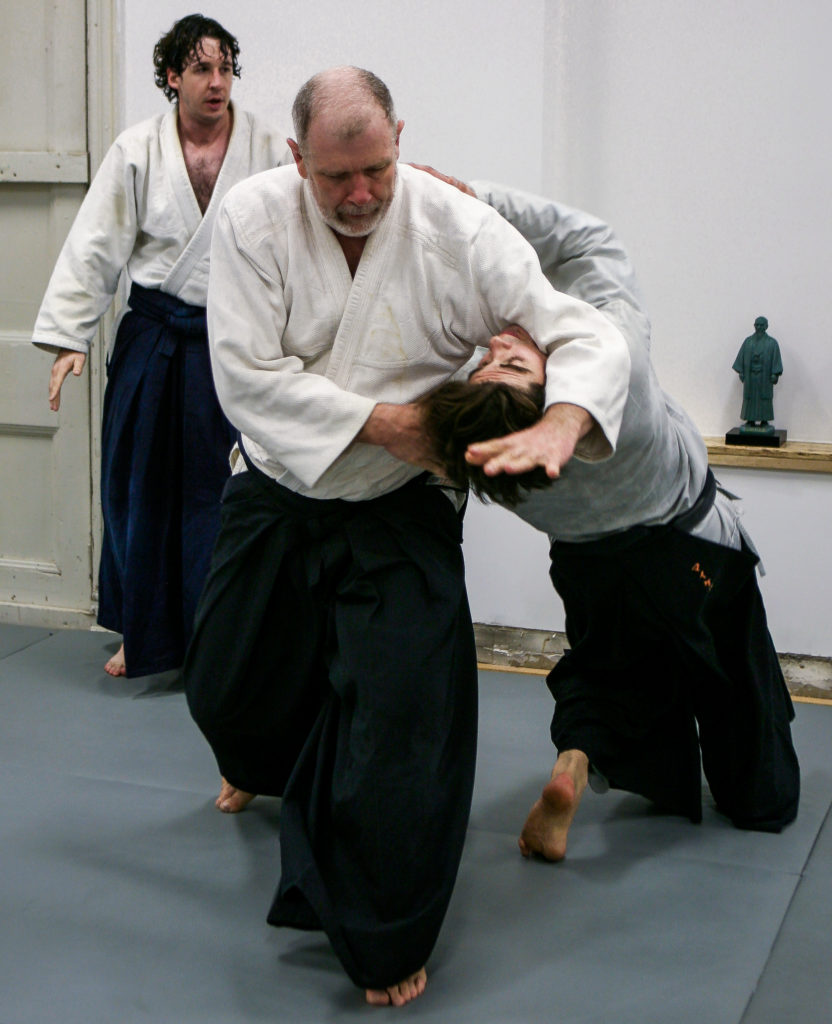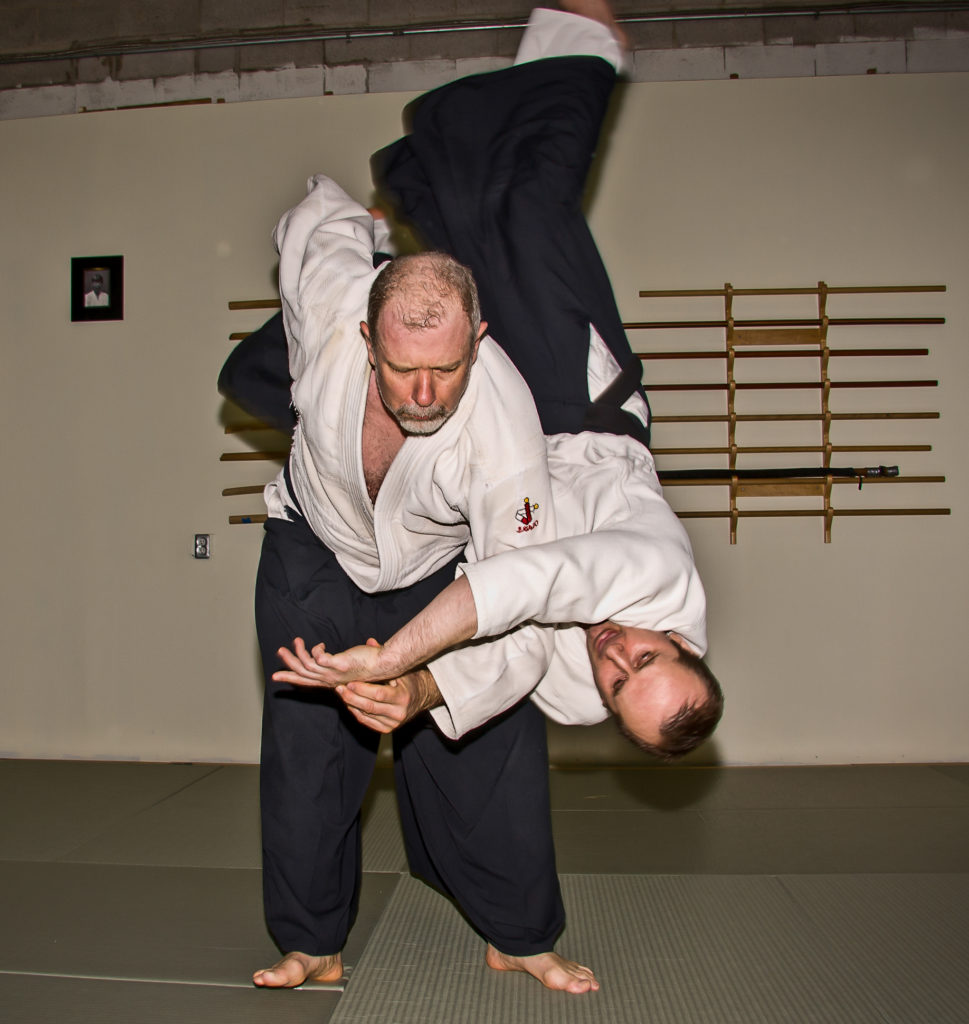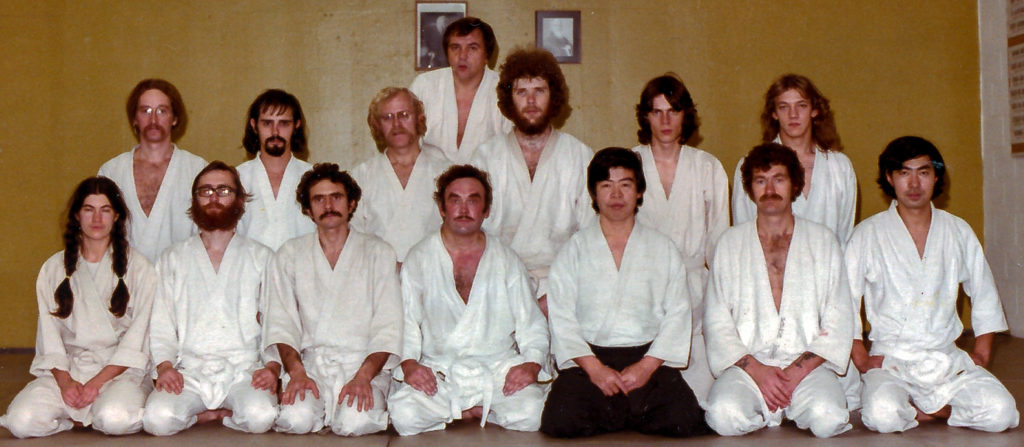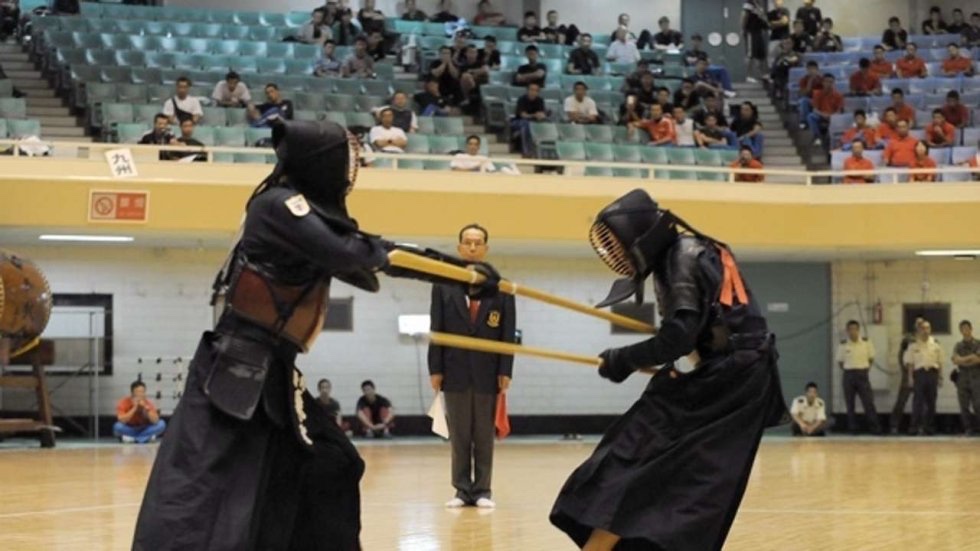Reminiscences of Kawahara-shihan, from
Yumi Nakamura, Jim Barnes, Rob Carroll, Barry Radun, John Hillson
(The following three notes were written about Sensei and compiled by Wil Wong when the annual Memorial Seminar had to be cancelled.)
Yumi Nakamura
I knew Kawahara sensei since the early 1970s, one year after I started Aikido in Kyoto, Japan.
I have so many memories from his public face and his private side.
I recall this story that shows his public face with his private, warm heart.
He was known to be an old-style Japanese martial arts teacher in many ways — his techniques and strict manners, etc.
A senior instructor from one of the CAF dojos came to me for advice regarding his student.
The story was that one of this instructor’s students got badly scolded by Kawahara sensei at a seminar. The guy was so upset about how Sensei was angry toward him and was so scared, he did not want to take a shodan test at all.
The instructor asked me to talk with Kawahara sensei about how this poor guy could change his behaviour and techniques.
When I had a chance to ask Kawahara sensei about the incident and the guy, he could not recall anything about it.
Then he said to me, “When I get mad at somebody, it is because I want to help them to improve and I do not hold that anger for later. So, I do not remember those upsetting situations at all “
He was such a great teacher.
Jim Barnes
I first met Kawahara-sensei in the late 1970s, when he took over Vancouver Aikikai. I was already a student there, and there was quite a buzz about him coming to the dojo. I was very curious about this renowned professional instructor.
I had practiced martial arts since I was a young teenager, and had had the experience of my teachers kicking my ass around the dojo rather painfully and without too much trouble before. I was also starting to be familiar with the excellent technique of the existing instructors at VA.
I assumed that Sensei would be qualitatively more of the same. I was to learn that he was on a different level that I could only dimly perceive.
He would often use me for ukemi, I think because I had a little rudimentary skill from my earlier jujitsu practice, unlike most other members.
I will never forget one very early experience when he told me to attack him with tsuki. Being young and dumb, I wanted it to be good, so I watched him intently for any kind of opportunity at all to time my attack as he walked toward me.
There wasn’t one. I felt like he was somehow reading my mind the whole way, and was always two steps ahead of me on whatever I was thinking about doing.
That delay was fatal. He walked right up to me and slapped me — not hard, and with a laugh. He knew exactly what had paralyzed me. “Just HIT!” he exclaimed.
My next attack was at least spontaneous and fast, even if all it got me was Sensei’s usual strict kotegaeshi.
Sensei spoke to me a couple of times over the years about the necessity of learning to read the attacker’s mind. (That’s still a work in progress, for me.)
A series of experiences like that gave me insight into just what a remarkable martial artist he was.
Rob Carroll
For many years I had the privilege of taking frequent ukemi for Kawahara sensei at seminars and classes of all sizes in Canada and abroad. While it was always challenging, it gave me the opportunity to feel sensei’s techniques directly. The sharpness, the precision, and the impressive solidness don’t translate into words.
Sensei was able to create an intense contact. One where all options for the uke would have immediate dire consequences. It wasn’t like a quick change of technique to a variation, or henka-waza, but rather just the direct effect of the impulse from uke. Push in harder, pull back (a really bad idea) or stay in place and hold firm….all with serious outcomes.
Kawahara sensei was determined to maintain the integrity of Aikido as a martial art. He would often link modern techniques to older related versions from the past. Usually this would start with the phrase “In the old days…” (insert terrifying variation) and then end with “but that’s not Aikido.” I can’t overstate the concern that hearing those words can instill in the uke.
Aikido is about learning through practice. Intense practice with a skilled partner is the best option. I have been honoured to be part of the memorial seminars, and find it regrettable that we cannot hold this year’s event. The best way to keep sensei’s legacy alive is through our efforts on the mat.
Barry Radun
At Aikido Kensankai in Montreal, the end of the night’s class was never the end of Aikido activities. When a group of us didn’t gather and make dinner at Ishiyama’s flat, we went out to have a casual meal of burgers and beer. I learned a very important lesson on one of those nights. I was sitting next to Kawahara-Sensei and everyone was in a festive mood. Sensei had ordered a beer and when it arrived, I insisted on paying for it, saying, as I would with any of my friends, “ No, no, Sensei. You can get it next time.” Of course, I didn’t actually mean that he should buy one for me the next time we went out. I thought nothing of it until Ishiyama approached me as we were getting our coats.
“Now you’ve done it,” he said. “What did I do wrong?/ I asked, much puzzled. “The next time we all go out, you must allow Sensei to buy you a beer,” he told me. “I don’t understand.,” I said. “You told Sensei that he could buy you a beer the next time. You should have simply bought him a beer, but, you told him he could buy one for you next time. You put him in a place of obligation and now he must buy you a beer or he will lose face.”
Of course, the next time we went out after class, Sensei bought me a beer and his obligation was discharged.
I learned that first night that we, in the West, often say things carelessly, without meaning them, and that words have weight. I also learned a tiny bit about how Japanese Sensei was. Much later, in Atlanta, the 2nd instructor had lived for many years in Japan and had married a Japanese woman. He told me he knew Kawahara-Sensei and that he could see Sensei’s Aikido in my Aikido. He also said that Kawahara-Sensei was one of the the most Japanese of the various Aikido shihan and I had learned from an excellent sensei. I was so pleased to hear that. My search for a sensei was to seek out the very traditional teachers. Part of my motivation was that I was a “Seeker” – a Seeker of a Master, a Seeker ofTruth and Wisdom, a Seeker of the Spiritual and Metaphysical. I was a Seeker of the Answers to the Great Mysteries. Sure enough, I found what I was looking for.
My looking for and finding a very traditional Master surprises me to this day. In so many things, I am not at all traditional. My approach has always been eclectic. No gods, no supernatural entities, no magic crystals, no affirmations, et al. And yet I found a very traditional teacher. Dear friends from the dojo in Atlanta teased me. “You talk about Kawahara-Sensei like he was the ideal of what a Sensei should be. He sounds like the wise old samurai in a movie.” I responded that I could only say the way he was. If Sensei sounded like Master Po from the TV show “Kung Fu”, I couldn’t help it.
Returning to the topic of words and their power. I had a mentor who taught me that me that the only thing of personal value we truly have and can give is our word. It is our most prized possession. This was also a learning I took from my “obligation” situation with Kawahara-Sensei.
As sensei in my own dojo, when people were leaving for the night, most would tell me, “I’ll see you tomorrow.” Of course, many didn’t show up the next day for class. After this happened a number of times, I addressed the dojo members in class.“When you leave after class, just say “Good night” or “Good-bye”. Don’t tell me you will see me the next class. When you say you will be here tomorrow, I take you at your word. I accept that things happen and you cannot come, but, when you give your word to be here, I have the expectation that you will be here.
If you don’t show up, I won’t say anything, but, the more you make hollow promises, I begin to disbelieve what you tell me. Better for you to say nothing and show up when you show up.” They improved and, as I hoped, they passed on the information to new members.
John Hillson
Aikiweb: This reminiscence appeared on Aikiweb. Please see: http://www.aikiweb.com/forums/showthread.php?t=25802
It Had To Be Felt #72: Kawahara Yukio: “Grab Me! Fight Me! Fight Me! (He was laughing)”
I am writing about Yukio Kawahara, the technical director of the Canadian Aikido Federation. I don’t feel I deserve to. Other people spent more years with him, started with him earlier, lived closer, or were clearly his preferred uke. I wish I’d had more time with him. It is hard to find one stand-out memory that will explain him to posterity.
He never really shared much about his early years, and I think he preferred that. Those memories sound horrible, the few I knew of. He lived a simple, and mostly solitary life in the present moment. He just wanted his students to get better.
He insisted on good manners—but he seemed to want a good heart. I was driving him to a seminar when an old man was laying on the ice with a bleeding face in front of us. I apologized to Sensei, got out of the car, and helped the man up and did a quick assessment. The man’s daughter came running to help. We got to the seminar a few minutes late, and Sensei never said a word about it. Years later, we watched a Zatoichi movie together, and he stopped the movie at one line of dialogue, where Zatoichi growled: “Samurai are selfish. They care only about their honor and not about human beings.” He turned to me and said, “John, you understand?
He took seemingly random moments as an opportunity for a lesson. He was a much better cook than I, and he bought a pressure cooker so that I could learn to make brown rice properly. He wanted a certain amount of water in the pot above the rice—he showed me how much by touching his own finger to his thumb. I had to gauge, from across the room, the exact depth of water that short distance translated to.
He was missing a thumb on one hand, but no one ever seemed to know why. It was such an obvious difference between his hands, and yet I could never feel the difference whenever he grabbed or struck me with either hand. After a training injury left me with a partially paralyzed arm, I have been looking more often to his example.
His curriculum was logical and methodical, and reflected what he wanted to see in his student’s aikido. Ikkyo to yonkyo was part of every test. When he grabbed, however he grabbed, he controlled my whole body. He told us once during a seminar that yonkyo used to be part of everything, and I find myself wondering if this is what he meant: his point of contact took my whole body.
One time, he did a nikkyo to me. He was working on something more. He looked intense. He shifted slightly, and my body shot forward. He shifted slightly again, and I skidded backwards. He was in complete control. I wasn’t taking ukemi; I felt like I was his curling broom sweeping the ice. Then, after taking down, he moved to the nikkyo pin. I didn’t feel my shoulder stretching; rather, I suddenly could not move my entire torso. I could not physically breathe, and not due to pain. Rather, my ribs and diaphragm were paralyzed, and my throat was closed. I watched him to it to others too—when he released the pin, one could hear an audible inhale.
Another time, he was demonstrating hijikime during a seminar. A white belt with me was not getting the angle or control. I tried quietly giving feedback. Suddenly Sensei was right there. He demonstrated on me. Nothing . . . nothing . . . “Hmm,” I thought, “maybe this won’t be so bad.” And then, explosive blinding pain turned the entire world turn white, and had me instantly sprawling on the floor. Like many of his techniques, this lock didn’t harm my elbow, but it took over my whole body. My arm was fine, but no thanks to my ukemi. I fell without even thinking of falling. It was all him.
Unlike any other teacher of my experience, he would take ‘what would you do if . . .’ questions from his students. We trusted him to not hurt us, and he seemed to enjoy the odd challenge. One friend asked, “Sensei, what would you do with a boxing jab?” “Hit me!” The punch never landed before a bear paw hand was right in my friend’s face.
Another friend studied some arnis. “Sensei, they like this slashing attack I’ve been wondering about.” My friend’s hand moved towards his belt (he had no knife on him but he never would have had a chance to draw one), and his hand was slapped away with knuckles driving down on his xyphoid process. The world went into slow motion and I never had a chance to blink before it was over.
A couple of us were using way too much strength in kokyudoza. Suddenly, we heard a snort. “Grab me! Fight Me! Fight Me! Fight Me!” He was laughing. I felt incredibly weak as I struggled. He stayed still. I was lifted straight up. He was connected to the earth and I was trying to move the planet. At least, that is the image I use to teach this now.
One of my dumber moments, I had a VHS of a demonstration showing nikkyo reversals. They all looked very easy to me. I showed it to him during lunch. “No good nikkyo!” I remember him grabbing my hand and suddenly was on my knees with no memory of how I got there, left arm in nikkyo. “R E V E R S E!!!” I was completely unable to move in any direction and the pain was shocking. No curling broom this time, I was firmly rooted to the spot and I felt like I was anchored beneath the floor. He let me up, we went back to eating lunch and my arm was perfectly okay. My cat then stole his chair, completely unafraid of him and oblivious to the events of a minute before. He was reluctant to move the cat, so I did. The cat jumped back in his lap, with a yowl that told Sensei the cat knew who was boss.
He was prolific. He was always able to show another way, always able to show crazy new levels of precision, always able to add something more. He learned from every source that came his way, and he was always creating something new. He taught me that learning was never finished, no source was off-limits. His aikido would embrace things that I never saw anywhere else.
I was used to sankyo hurting as we students drove each other up. He came by after class—and suddenly I was balanced on my tip toes. I couldn’t sink. I couldn’t step in any direction. Nothing hurt. I was completely controlled as always, but completely comfortably stuck floating. He kept up a relaxed conversation with another person, leaving me dangling in the air for a minute. This was new territory for me.
Not long after, he had to be admitted to hospital. I spent the night in his hospital room in the chair beside his bed. I was there for his first blood transfusions. We had a brief afternoon pass the next day, and I was having a hard time coming to terms with what his apparent illness meant. We would only get worse news in the week ahead. We were in the local dojo-cho’s house for tea. “Sensei feels different today. He wants you to grab him.” I grabbed him katatedori. I grabbed a wave that whipped my head down and lifted my heels, stuck me up my tip toes with my nose pointed at my kneecaps. I had no momentum in any direction. I was too far up on my toes to lower the soles of my feet to the floor. I was caught there for what felt like an eternity with my ass sticking up in the air and my arms flapping wildly. I had to wave my arms to fall back enough to get my feet under me. By the time I could look up, Sensei was already sitting back in his chair, looking at me with the most monumentally smug self-satisfied smirk I ever saw. I think he was sending me a message, that he was going to recover and he was going to have years left in him—and he was right.
